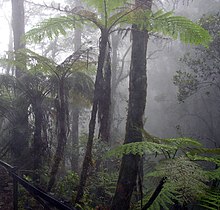Humid
| Humidity and hygrometry | |
|---|---|
 |
|
| Specific concepts | |
| General concepts | |
| Measures and Instruments | |
Humidity is the amount of water vapor present in the air. Water vapor is the gaseous state of water and is invisible. Humidity indicates the likelihood of precipitation, dew, or fog. Higher humidity reduces the effectiveness of sweating in cooling the body by reducing the rate of evaporation of moisture from the skin. This effect is calculated in a heat index table or humidex. The amount of water vapor that is needed to achieve saturation decreases as the temperature increases. As the temperature of a parcel of water becomes lower it will eventually not reach the point of saturation without adding or losing water mass. The differences in the amount of water vapor in a parcel of air can be quite large. For example, a parcel of air that is near saturation may contain 28 grams of water per cubic meter of air at 30 °C, but only 8 grams of water per cubic meter of air at 8 °C.
There are three main measurements of humidity: absolute, relative and specific. Absolute humidity is the water content of air at a given temperature expressed in gram per cubic meter.Relative humidity, expressed as a percent, measures the current absolute humidity relative to the maximum (highest point) for that temperature. Specific humidity is a ratio of the water vapor content of the mix to the total water content on a small basis.
Absolute humidity is the total mass of water vapor present in a given volume of air. It does not take temperature into consideration. Absolute humidity in the atmosphere ranges from near zero to roughly 30 grams per cubic meter when the air is saturated at 30 °C (86 °F).
Absolute humidity is the mass of the water vapor , divided by the volume of the air and water vapor mixture , which can be expressed as:
...
Wikipedia


